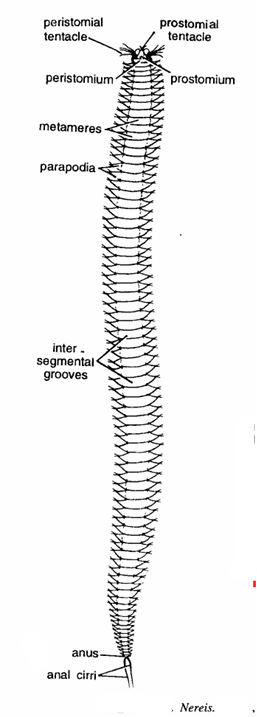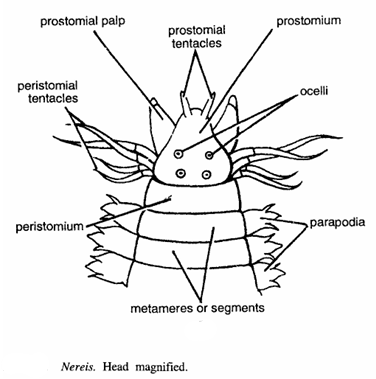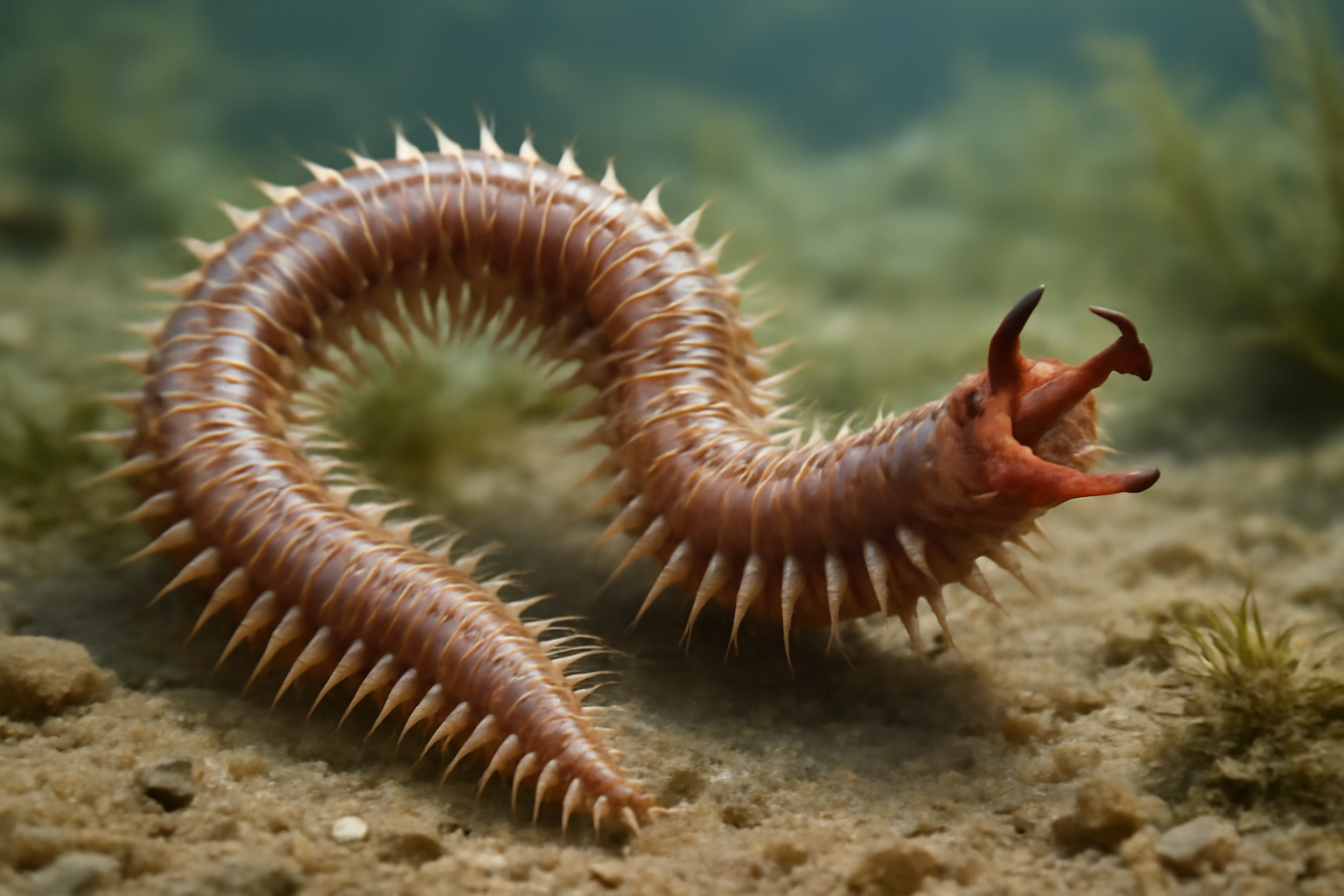Nereis: Biology, Classification, Habitat, and Life Cycle of the Marine Polychaete Worm
Introduction
Nereis, commonly known as ragworms or clam worms, is a genus of marine polychaete worms belonging to the family Nereididae. These worms are one of the most widespread and abundant annelids found in marine environments, particularly in sandy and muddy coastal areas. Nereis species play vital ecological roles, including sediment aeration and serving as important prey for fish, birds, and other marine animals. Their intricate anatomy, segmented body with parapodia, and complex life cycle make them key study organisms in marine biology and invertebrate zoology.

Classification of Nereis
| Taxonomic Rank | Name | Characteristics |
|---|---|---|
| Kingdom | Animalia | Multicellular organisms with complex tissues |
| Phylum | Annelida | Segmented worms with metamerism |
| Class | Polychaeta | Marine bristle worms with parapodia |
| Order | Phyllodocida | Active free-moving polychaetes with well-developed parapodia |
| Family | Nereididae | Polychaetes with strong jaws and prostomial palps |
| Genus | Nereis | Marine worms with segmented bodies and two types of setae |
Habit and Habitat
Nereis are free-living, predaceous worms primarily found in marine environments. These worms inhabit temporary burrows in sandy and muddy substrates, often along intertidal and subtidal zones. They are nocturnal carnivores, actively scavenging or hunting small invertebrates during the night. Nereis worms might also be found clinging to seagrass or algae in rocky coastal regions. Their burrowing behavior promotes sediment aeration, aiding in nutrient cycling within benthic ecosystems.
Geographical Distribution
Nereis species boast a cosmopolitan distribution, present in seas and oceans worldwide. They are abundant along the North Atlantic coast, Pacific coasts of the USA and Asia, as well as European shorelines. Their adaptability allows them to thrive in diverse marine conditions, ranging from temperate to tropical waters. Many species display localized adaptations to their specific habitats, contributing to a rich biodiversity within the genus.

General Characteristics
- Commonly called as Rag worm or Clam worm and is the simplest annelid.
- Examination of preserved specimen shows cylindrical and elongated body form which is divided into similar metameres or segments about 200 in number.
- First few segments fuse to form head which is composed of (i) prostomium or preoral lobe, which carries prostomial tentacles, palps and ocelli; and (ii) peristomium (2 segments fused), which carries antero-laterally 4 pairs of peristomial tentacles.
- Mouth is found on the anterior surface of the peristomium.
- Body segments, except head and anal segment, contain each pair of locomotory parapodia. Segments are also called as metameres and between two segments in intersegmental groove.
- Parapodia also serve as respiratory and circulatory organs.
- Each parapodium is composed of dorsal notopodium and ventral neuropodium.
- Parapodium also possesses aciculum for support and needle like setae for crawling.
- Anal segment contains a pair or anal cirri. Nereis is dioecious, although male and female worms can hardly be recognized.
- Body Structure: Elongated, cylindrical, and dorsoventrally flattened with well-defined segmentation (metamerism), typically comprising about 80 to 200 segments.
- Head: The head includes a prostomium bearing two pairs of eyes, paired antennal tentacles, and a pair of short two-jointed palps. The peristomium follows, with four pairs of tentacular cirri.
- Parapodia: Each segment, excluding the head and terminal segments, features biramous parapodia equipped with two types of setae—acicular (supportive) and locomotor bristles.
- Locomotion: Parapodia facilitate crawling and swimming.
- Circulatory System: Closed circulatory system.
- Digestive System: Complete with an eversible muscular pharynx armed with conical jaws.
- Respiration: Occurs primarily through body surface and parapodial lobes.
- Reproduction: Dioecious, with external fertilization and a trochophore larval stage.
- Sensory Organs: Developed eyes, statocysts, and sensory cirri allow environmental interaction and predator detection.
Special Features
- Eversible Pharynx: Nereis possess a muscular pharynx capable of being turned inside out, armed with strong jaws used to capture prey.
- Bristles (Setae): Two types of setae on parapodia aid in movement and burrowing.
- Reproductive Adaptations: Separate sexes release gametes into the water for external fertilization.
- Larval Development: The trochophore larva resembles molluscan larvae, indicating evolutionary ties within the Lophotrochozoa superphylum.
- Photoreception: The presence of eyes allows Nereis to detect light, aiding their nocturnal lifestyle.
- Locomotion: Adapted parapodia allow efficient crawling in sediment and swimming in water.

Identification
Nereis species can be identified by their distinctive morphological traits:
- Body Segmentation: The clear division of the body into multiple segments with biramous parapodia.
- Head Morphology: Presence of prostomium with two pairs of eyes and tentacular structures.
- Setae: Different types of bristles (acicular and locomotor) are visible on parapodia.
- Pharynx and Jaws: Eversible and equipped with conical teeth.
- Size: Species may range from a few centimeters up to 30 cm in length depending on species and environment.
- Coloration: Body coloring varies but usually includes shades of brown, reddish, or greenish hues.
- Reproductive State: Identification of males and females can be challenging, but mature individuals are distinguished via gonadal examination.
Life Cycle
Nereis exhibits a complex life cycle characterized by sexual reproduction with distinct sexes. During the breeding season, males and females release sperm and eggs respectively into the water column (spawning). Fertilized eggs develop into free-swimming trochophore larvae, characterized by bands of cilia allowing locomotion and feeding. These larvae undergo several developmental stages before metamorphosing into juvenile worms that settle on the substrate and grow into adults.
This indirect development helps dispersal and colonization of new habitats, contributing to their wide distribution.
Ecology and Importance
Nereis worms play vital roles in marine ecosystems:
- Sediment Engineering: Their burrowing creates channels that improve oxygen penetration and sediment mixing.
- Food Source: They are preyed upon by fish, crustaceans, and birds, thus forming a crucial part of the marine food web.
- Bioindicator Species: Due to their sensitivity to environmental changes, Nereis species are often used to monitor pollution and habitat health.
- Scientific Study: Their well-described anatomy and life history make Nereis models in research on neurobiology, regeneration, and developmental biology.
Conclusion
Nereis exemplifies the complexity and adaptability of marine polychaete worms. Their segmented bodies, complex reproductive strategies, and active predatory lifestyle distinguish them as important ecological and biological entities. Understanding Nereis biology aids in the broader comprehension of marine benthic ecosystems and offers insights into annelid evolution.
References
- https://en.wikipedia.org/wiki/Nereis
- http://www.marinespecies.org/aphia.php?p=taxdetails&id=129379
- https://animaldiversity.org/accounts/Nereis/classification/
- http://www.marinespecies.org/aphia.php?p=taxdetails&id=130404
- https://www.svc.ac.in/SVC_MAIN/Departments/Zoology/Museum/MuseumData/1.%20NON%20CHORDATA/7_ANNELIDA/1.7%20ANNELIDA.pdf
- https://www.mindat.org/taxon-2308106.html
- https://invasions.si.edu/nemesis/jtmd/species_summary/nereis%20pelagica
- https://en.wikipedia.org/wiki/Nereididae
- https://www.synopsisias.com/public/osm/general-features-and-life-history-of-nereis-NjY0MA==
- https://www.inaturalist.org/taxa/81791-Nereis
